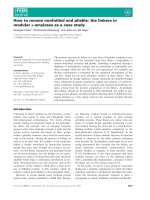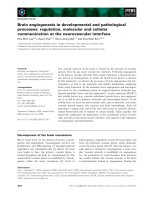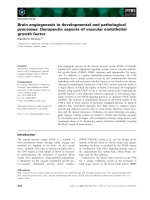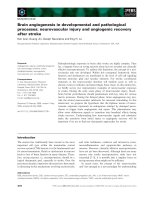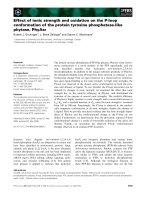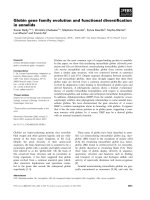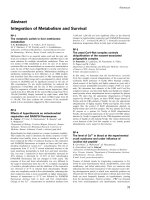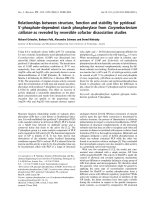Tài liệu Báo cáo khoa học: "ANAPHORA RESOLUTION: SHORT-TERM MEMORY AND FOCUSING" pptx
Bạn đang xem bản rút gọn của tài liệu. Xem và tải ngay bản đầy đủ của tài liệu tại đây (864.44 KB, 10 trang )
ANAPHORA RESOLUTION: SHORT-TERM MEMORY AND FOCUSING
RAYMONDE GUINDON
Microeleotronlcs and Computer Technology Corporation
(MCC)
9430 Research Blvd.
Austin, Texas ?8759.
ABSTRACT INTRODUCTION
Anaphora resolution is the process of
determining the referent of ~uaphors.
such as definite noun phrases and
pronouns, in a discourse. Computational
linguists, in modeling the process of
anaphora resolution, have proposed the
notion of focusing. Focusing is the
process, engaged in by a reader, of
selecting a subset of the discourse
items and maJ£ing them highly available
for further computations. This paper
provides a cognitive basis for anaphora
resolution and focusing. Human memory
is divided into a short-term, an
operating, and a long-term memory.
Short-term memory can only contain a
small number of meaning units and its
retrieval time is fast. Short-term
memory is divided into a cache and a
buffer. The cache contains a subset of
meaning units expressed in the previous
sentences and the buffer holds a
representation of ~he incoming sentence.
Focusing is realized in ~he cache that
contains a subset of the most topical
units and a subset of the mos~ recent
units in the text. The information
stored in the cache is used to integrate
~he incoming sentence with the preceding
discourse. Pronouns should be used to
refer to units in focus. Operating
memory contains a very large number of
units but its re~rleval time is slow.
It contains the previous tex~ units that
are not in the cache. It comprises the
tex~ units not in focus. Definite noun
phrases should be used to refer to unite
not in focus. Two empirical studies are
described that demonstrate the cognitive
basis for focusing, the use of definite
noun phrases to refer to antecedents not
in focus, and the use of pronouns to
refer to antecedents in focus.
The
goal of thls research is to
show the relation between the
psychological work on anaphora
resolution based on the notion of a
limited short-term or working memory and
the computational linguistics work based
on the notion of focusing.
This rapprochement is important for
the following reasons:
I) From a theoretical viewpoint.
cognitive evidence increases the
validity of the computational notion of
focus.
2) Focusing corresponds to one of the
reader's comprehension processes and it
needs to be incorporated in the model of
the user in language understanding
systems to adequately resolve
am~iguitles in the user's utterances and
to handle language generation.
FOCUSING IN COMPUTATIONAL LINGUISTICS
According to Grosz
(1977).
who was
interested in ~he resolution of definite
noun phrases, focusing is the process.
engaged in by participants in a
discourse, of highlighting a subset of
their shared reality. Grosz. Joshi. and
weinstein (1983) distinguish between two
levels of focus, global focus and
centerimg. Global focusing is a major
factor in maintaining global coherence
and in the interpretation of definite
noun phrases. Centering is a major
factor in maintaining local coherence
and in the interpretation of pronouns.
Grosz. Joshi. and Weinstein further
define the notion of centering. Each
sentence has two types of centers whose
purpose is
to
integrate the sentence
to
the discourse. The backward-looking
center links the current sentence to the
preceding discourse. The set of
forward-looklng centers provides th~ set
of entities to which further anaphors
m~y refer. The b6okw~rd-looklng center
corresponds, roughly to Sidner's focus
and the forward-looklng centers to
Sidner's potentla~l fool.
~8
• L
One principle derived by Grosz,
Joshl, and Weins~ein is the following:
if the b~okward-looking center of the
ourren~ utterance is the same as the
baokward-looklng cen~er of the previous
utterance, a pronoun should be used. In
other
words, if there are no ~oplc
shifts, continue to refer to the same
entity by using a pronoun.
However, violations of- this
principle have been presented in Grosz
(1977) and noted in Grosz, Joshl, and
Welns~eln (198~).
They
have shown that
pronouns are sometimes used to refer to
entities mentioned many sentences back,
even though the backward-looklng center
of intervening sentences has been
changed by topic shifts.
Sidner (19V9. 1983) has proposed
the notion of focus in the context of
interpreting anaphors, especially
pronouns. In Sidner's theory, an
anaphor neither refers ~o another word
nor co-refers to another word. but
rather co-specifies a cognitive elemen~
in the reader's mind. Moreover. a
theory of an&phora resolution must
predict the pattern of reader's correct
and incorrect choices of co-specifiers
and ~he failures ~o understand. This
view makes explicit the consideration of
the reader's mental model and
inferential capa~bili~ies
A sEetch of Sidner's focusing
process follows. First. an initial
focus is selected on the basis of
syntactic features and thematic roles
indicating toplc~lity in the flrs~
sentence. Other elements introduced in
the sentence are stored as potential
loci for later sentences. When an
anaphorlc expression is encountered.
this focus is tested as a co-speclfler
for ~he anaphor. It has to satisfy
syntaotlo res~rlo~ions on co-references
(L~snlk, 1976), semantic seleo~ional
restrlo~ions (Katz and Fodor, 1963), and
pragmatic plausibility oons~raln~s
expressed in the remainder of the
sentence. If the focus fails ~s a
co-speclfier for the ~n~phor, the
potential fool are tried in turn. At
the same time, the new elements
introduced in the sentence are stored as
potential loci for later sentences.
Third, the focus is updated to the
selected co-speclfler for the anaphor.
If the focus has changed, a topic s~ift
has occurred. The second and third
s~eps are cyclically applied after each
sentence.
The advantage of using a focus
mechanism is tha~ it
priorltlzes and
restrlc~s
the
search for a co-speclfier,
and as a consequence, reduces the
oomputatlon~l costs assoolated with
inferential processing when testln~ the
applicability of the oo-speclfler to the
anaphor.
COGNITIVE STUDIES OF ANAPHORA RESOLUTION
A few representative empirical
studies of anaphora resolution are
described below. All the experimental
par~dlgms used share the following
assumptions:
1) human memory is func~ionally or
s~ruc~urally divided into at least two
types of memories, a short-term memory
with small storage capacity but very
fast retrieval time and a long-term
memory with very large s~orage capacity
but slow retrieval time:
2) a topic shift transfers the units
currently in short-term memory to
lon~-term memory:
3) ~n anaphor transfers its referent
from long-term memory to short-term
memory (i.e. reinstates its referent),
if it was not already in short-term
memory.
The first assumption is crucial.
Other things being equal, computations
involving retrieval from short-term
memory will be faster than those
involving retrieval from long-term
memory. Turning to the second
assumption, topic shifts have been found
to be induced wlth a varify of
linguls%ic devices. One of
the
devices
is the introduction of intervening
sentences between the referent and its
anaphor. The intervening sentences are
unrelated zo the referent but related to
the overall text. Another device is the
specification of a temporal or Spatial
parameter that is outside the normal
range of a situation. When describing a
dinner, the
phrase
"Five hours later,"
signals ~h~t
the
topic of conversation
is no longer
the
dinner. Another device
is
the
use of an anaphor, frequently a
deflnlte noun phrase, to refer to an
antecedent tha~ is not currently the
topic of conversation bu~ is in
the
"background". Finally,
there
is
the
use
of key phrases to signal a diversion in
the flow of discourse, such as "Let's
turn to.". as documented in Relchman
(1978, 1984).
The general pattern for the
material used in these experiments is
the following. A~ the beginning of the
tex~ appears a sentence containing a
referent (e.g. biologist). For
example, "The mission included a
biologist". Then, if ~he referent
should not be in focus,
the
nex~
sentence or sentences indloate a topic
shift as described aJ3ovs (e.g.
~9
unrelated intervening sentences). If
the referent should be in focus, no
devices for topic shifts are used. The
following sentence then contains an
an&phor (e.g. scientist, he) to the
focused or non-focused referent (e.g.
biologist). For example, "The scientlst
collected samples from the cultures".
Another example is shown in Table 1 of
this paper.
Carpenter and Just (1977) used eye
traoklng with other converging
techniques to study anaphora resolution.
Wlth eye tracking, one can monitor very
precisely the trajectory of the eyes,
with their forward and regressive
movements, and the duration of eye
fixations on small segments of the te~.
The assumption behind using this
technique is that eye movements are
closely related to higher level
cognitive activities such as
comprehension. Therefore. one can
expect longer fixation durations on text
segments requiring additional processing
to be comprehended and one can expect
the eye movement pattern to mirror the
selective pickup of important
information in the text.
They performed a series of
experiments testln~ the effect of
recency of a referent on the time course
of anaphora resolution. Indirectly.
they tested the effect of recency on the
availability of an item in short-term
memory. They presented texts where the
number of sentences between the referent
and the anaphor was varied from zero to
three. The subjects read each sentence
and. after the sentence, had to decide
whether it was consistent or
inconsistent with the previous
sentences. The consistency Judgment
times and the eye fixations were
recorded. The consistency Judgment
task, used as converging evidence with
the eye movement technique, is believed
to induce the subjects to integrate each
new sentence and should pars,llel the
difficulty of ~phora resolution. The
overall reading time of the ~n&phorlo
sentence was measured using the eye
tracking technique. Each of these tasks
should be faster if the referent was in
short-term memory than if the referent
was in long-term memory.
Response times for the consistency
Judgments and reading times of the
anaphorlc sentences increased as the
n-mher of intervening sentences
increased. The sharpest difference
appeared between zero and one
intervening sentence. Gaze durations
within the anaphorlo sentence
were
shorter when there were no intervenlng
sentences th~n in the other conditions.
These results show not only that
&naphora resolution is easier when the
referent is nearer the ~naphor but also
that one intervenln E sentence may be
sufflolent to produce a topic shift.
Clare and Sengul (1979) used the
sentence reading time technique to study
anaphora resolution. In this technique.
subjects control the onset and offset of
the presentation of a sentence by
pressing a button. The subjects are
instructed to press the button to see a
new sentence as soon as they have
understood the current sentence. The
assumption behind this technique is that
additional processing required for
comprehension will increase sentence
reading time.
Clare and Sengul (1979) measured
the reading time of a sentence
containing an anaphor. They
distinguished between two models of the
effect of recency of a referent on the
speed of ~naphora resolution. In the
first model, called the "continuity
model", entities mentioned in the
discourse are searched backward from the
last one. One should expect
monotonically increasing re~din~ time as
the searched entity is farther back. In
the second model, called the
"discontinuity model", entities
mentioned in the current or last
sentence are kept in short-term memory
and accessed first. All the entities
that are further back are more likely to
be in long-term memory (and not in
shor~-term memory) and accessed second.
Subjects rea~ short paragraphs
where a referent could be separated from
the anaphor by zero ~o two intervenin~
sentences. The readln~ time of ~he
sentence containing the anaphor was fast
when the referent was in the immediately
preceding sentence but ~allx ~ when
it was two or
three
sentences before.
This finding supports the discontinuity
model. Entities in the last processing
cycle are more likely to be kept in
short-term memory than entities in
previously processed cycles. Once a
tex~ entity is not in short-term, the
number of intervening sentences does not
affect the speed of an~phora resolution.
Lesgold, Roth, and Curtis (1979),
who related the linguistic notion of
foregrounding (Chafe, 1972) to ~he
psychological notion of short-term
memory, performed a series of
experiments similar ~o those of Clark
~nd Sengul (1979), using more varied
ways to produce topic shifts, and
replicated the above findings.
220
McKoon and gatoliff (1980) used an
activation procedure based on Chang
(1980). A desoriptlon of the baslo
paradigm and its underlying loglo
follows. When one reads a text, only a
small part of the text information is
stored in short-term memory and most of
the information is stored in long-term
memory. This is due to the very small
storage capacity of short-term memory (7
t2 chunEs; Miller, 1956). Given that
retrieval time in short-term memory is
much faster than retrieval time in
long-term memory, it will tame longer to
remember something from the text if the
memory is stored in long-term memory
than in short-term memory.
In their study, subjects read a
paragraph sentence by sentence.
Immediately after the last sentence, the
subjects were presented with a single
word and the subjects had to remember
whether the word had appeared previously
in the text or not (an old-new
recognition). If the tested word was
still in short-term memory, the old-new
recognition time should be faster than
if it was in long-term memory.
To test this hypothesis, the
paragraphs were constructed in the
following manner. The referent (e.g.
burglar) was separated from the anaphor
by either zero or ~wo in~ervenlng
sentences. The anaphor appeared in the
last sentence of the paragraph. The
last sentence was presented in one of
three versions: i) the subject of the
sentence was a repetition (i.e.
burglar) of the referent in the first
sentence (anaphorio-identioal); 2) the
subject was the name of the category-
(e.g. criminal) in which the referent
belonged (anaphorlc- category); 3) the
subject was a noun (e.g. ca~) unrelated
~o the referent (non-anaphoric). During
the experimental trials, the "referent"
(i.e. burglar) was presented
immediately after the last sentence for
an old-new recognition.
Assuming that an anaphor activates
its referent by making it available in
short-term memory, one can expect
slgnifloantly faster old-new recognition
times for "burglar" in the
anaphorlc-ca~egory oondi~lon than in the
non-anaphorlo condition. This
prediction was observed.
Surprisingly, the number of
intervening sentences did not have an
effect. This suggests that the two
intervening sentences did not remove the
referent from short-term memory (i.e.
"backgrounds" the referent). It is
probably not the case. Rather. i~ is
llkely that by testing the referent at
the end of the clause, as opposed to
when the anaphor is encountered, the
referent had time to be reinstated in
shor~-term memory and be highly
available. This is an important point.
The activation procedure was not on-llne
since the old-new recognition ocoured at
the ~n~ of the sentence as opposed to
M~ll~ the sentence was read and the
anaphor encountered.
Another initially surprising effect
was that ~he old-new recognition times
for the referents were slower in the
zero intervening sentences when the
anaphor was a repetition of the referent
itself than when the anaphor was the
category name. This last result
suggests that it is not appropriate to
use a definite noun phrase, especially a
repetition of the referent, to refer to
a antecedent in short-term memory.
As explained previously,
intervening sentences are not the only
devices that transfer text units from
short-term to long-term memory.
Stereotypical situations have spatial
and temporal parameters with legal
ranges of values. If one specifies a
spatial or ~emporal value outside these
ranges, a scenario-shift occurs. For
example. Anderson (in Sanford and
Garrodo 1981) constructed texts about
stereotypical situations such as going
to a restaurant. In one sentence of the
text, there was a reference to a
character related to the script, say a
waiter. AZ the beginning of the next
sentence, there was a mention of a
temporal or spatial parameter, such as
"One hour later" or "Five hours la~er".
In the flrs~ case the parameter is
within the range defining the scrip~, in
the second case it is not. The rest of
~he sentence contained an anaphor to the
previously mentioned character, the
walter. Measumlng ~he reading time of
the anaphorlo sentence. Anderson showed
longer reading time when the spatial or
temporal parameter w~s outside the range
of the script th~n inside. This
suggests that the referent was
transfered from short-term to long-term
memory by the scenarlo-shlft and it took
longer ~o retrieve the referent during
anaphora resolution.
The results from all these
experiments support the notion tha~ an
anaphor activates its referent by malting
it highly available in short-term memory
and ~hat topic shifts transfer units
from short-term memory to long-term
memoz'y. However. none of these studles~
except some eye movement siudles.
provide data on ~ anaphora resolution
occurs during the reading of a sentence
~nd when i~ ooou2s in relation to the
2~
lexioal, syntactic.
pragmatic analyses.
semantic,
and
COGNITIVE BASIS FOR FOCUSING
A sketch of a cognitive model of
anaphora resolution is offered here. It
has been heavily influenced by the
short-term~long-term
memory model of
Kintsch and van DiJk (19~8) and
especially its leading edge strategy.
~tructure ~f ~ memg/~
Analogically, human memory can be
conceptualized as a three level
structure similar to the memory of most
mini and main frame computers. It
consists of a small, very fast memory
called short-term memory (STM); a
relatively larger main or operating
memory (OM): and a vast store of
general world knowledge called long-term
memory (LTM).
The total STM is only large enough
to contain 7t2 chunks of information at
any one time (Simon, 1974; Miller.
1956).
The resources for STM are
dynamically allocated to one of two
uses. First, par~ of the STM is used to
store the incoming sentence or clause.
This is a temporary storage of the
sentence or clause before further
processing and is called the STM buffer.
The second part of STM is called the STM
cache. It is used to hold over. from
one sentence or clause to the next. the
information necessary to provide local
and global coherence. It contains a
subset of the previous text items that
are topical and a subset of those that
are recent. Retrieval times from
short-term memory are very fast.
Conceptually. operating memory is
the subset of the world knowledge in
long-term memory which is deemed
relev~n~ to the prooesslng of the
current par~ of the text. It also
contains the growing memory structure
oorrsspondin~ to the tex~ read so f~r.
I~ contains the less topical and less
recent information from the text.
Retrieval times are much longer than for
short-term memory.
The time course of anaphora
resolution is greatly determined by the
current content of shor~-term memory and
of operating memory. Moroever, pronouns
and definite noun phrases are resolved
using different s~rategies.
Cache ~. During the input
of a sentence into the buffer ~nd the
concurrent integration of
the
sentence
into
the
cache, a subset of the semantic
units held in the STM is selected to be
held over in the cache for the next
cycle. Following Elntsch and van Dijk
(1978), the cache management strategy
selects a subset T of the most topical
items and a subset R of the most recent
items to be held over in the cache. The
selection strategy aims at m~xlmizin~
the probability that an anaphor in the
nex~ sentence will refer to a semantic
unit held in the cache. Cache
management is applied after each
sentence or clause.
Pronouns and definite noun phrases are
resolved using different strategies, we
will describe four cases:
i. The anaphor is a definite noun
phrase and the referent is not
in focus, that is, i~ is in
operating memory,
2. The anaphor is a definite noun
phrase and the referent is in
focus, that is. it is in the
cache.
3.
The anaphor is a pronoun and
the referent is in the cache
(in fOCUS).
4.
The anaphor is a pronoun and
the referent is in operating
memory (not in focus).
It is hypothesized that the
explicitness of sm anaphor is a signal.
used by the readier, which denotes
whether the referent is in the cache or
in operating memory.
If the ~naphor is a definite noun
phrase, operating memory is searched
immediately. If the referent is in
operating memory it is then reinstated
into the cache. A topic shift has
occured.
If the anaphor is a definite noun
phrase and the referent is in focus
(i.e. in the cache), anaphora
resolution will be hindered. The reader
searches operating memory while the
referent is in short-term memory.
Correspondingly. this violates a rule of
cooperative communication: use a
definite noun phrase to refer to an
~ntecedent not in focus.
The
definite
noun phrase signals a topic shift, while
in fact. the same entity is being talked
about.
999
If the anaphor is a pronoun, the
cache is searched for a plausible
referent. If found, mnaphora resolution
is completed. Because cache management
is based on topioallty and recency,
pronouns can refer to ~he main ~opio of
~he text even when
the
main ~opio has
no~ been mentioned directly for mamy
sentences. Unless there is a global
~opic shift, the main topic in the cache
remains unchanged throughout ~he text.
If the anaphor is a pronoun but no
referent is found in the cache, it is
then necessary to search operating
memory. If a referen~ is found in
operating memory, it is reinstated into
the c~che. A ~opic shift has occured.
Using a
pronoun
~o refer ~o information
in operating memory is de~rlmental ~o
amaphora resolution.
The
reader first
searches the cache. ~hen ~he operating
memory, and ~hen has ~o relnst~te ~he
referent into
the
cache.
COMPARISONS
A clear relation exists between ~he
notion of focusing proposed in
computational linguistics and the model
of human memory and discourse processing
proposed in cognitive psychology.
The Q~h~ is used to store
the
items in f.~Q~. Given the small number
of
items
stored in the cache, a sketchy
anaphor such as ~ ~ is sufflclen~
to retrieve the referent. The cache
management strategy in human .memory is
aimed at maximizing ~he probability that
the cache contains the information
relevant to the next cycle of
computation. The cache, by containing
topical and recen~ i~ems, allows to
maintain global and local coherence.
Q~ m~y~ is used ~o store
items that are not in f~A~. Because
the set of items is large, an
informative descrlp~ion of the Item ~o
be searched for is needed. D~fi~i~
~ou~ ~h/~es a/e used ~o indlc~te to the
reader ~ha~ the
i~em
is no~ in focus.
thus In operating memory. Other things
being equal, it will tame more time to
retrieve an item from operating memory
than from the cache. The referent will
need to be reinstated into
the cache.
This will produce a topic shift. The
reinstated referent is then highly
available and can be referred to by
using a pronoun.
TWO ON-LINE STUDIES OF ANAPHORA
RESOLUTION
The presented studies test the
notion tha~ focus is cognltively
realized in the reader's limited
short-term memory.
They
also test
Grosz. Joshl. and Welnsteln's claim that
definite noun phrases, and not pronouns,
should be used to refer ~o items no
longer in focus and ~hat pronouns, ~nd
not definite noun phrases, should be
used to refer to items in focus.
Moreover, if one assumes that the
content of short-term memory is
dynamically updated on ~he basis of
recency ~nd topicality, one can explain
why pronouns can be used to refer Zo
recent items ~nd also to topical
non-recen~ items.
A new technique, called Q~zli~
~iQn, was developed specifically
to provide the empirical da~a for these
studies. The on-line activation
technique can be compared to "closely"
tracing the execution of ~ program.
In
the
on-line activation
technique, passages are presented using
rapid serial visual presentation (RSVP),
one word a~ a time. In ~dditlon to
reading each text. the participants were
also given the ~ask to recognize whether
some specially marked words, presented
surreptitiously wi~hln ~he ~ext, had
appemred before in the tex~ or not.
Some of ~hese special words were
presented before in the text and others
were not We will call ~hese specially
marked words zest words. This task is
called am old-new recognition task.
The passages contained anaphors
referring ~o antecedents which were
either in focus or not in focus. An
antecedent was removed from focus by
introducing a topic shift, with ~he
restrlc~ion that
the
antecedent was not
the
main topic of the discourse. An
example ter~ is presented in table I.
Note that only one of
the
alternative
sentences 5a, 5b. or 50 was presented
for each text to the participants of the
study.
In each text. one of the test words
was the referent of the anaphor. At
some point before or after the anaphor
was presented on the CRT, its referent
was presented for old-new recognition
and recognition times and errors were
collected. The delay between the onse~
of the anaphor and the onset of the test
word is called the stimulus onset
asynchrony (SOA). The ~naphor is acting
as a prime, which should activate the
referent. The old-new recognition time
for
the
referent test word indicates
223
whether the referent is in the cache or
in operating memory.
TABLE 1
EXAMPLE OF TEXTS WITH ANTECEDENTS
IN FOCUS AND NOT IN FOCUS
Antecedent: thermometer
Anaphor: instrument
Antecedent in Focus
1- The assistant was preparing
solutions for a chemistry experiment.
2- The experiment would take at least
four hours.
3- There would then be a ten hour wait
for the reaction to complete.
4- He measured the temperature of a
solution using a thermometer.
5a- The thin instrument was not giving
the expected re~ding.
5b- A broken instrument was not giving
the expected reading.
5c- The compuzer terminal was not giving
the expected reading.
Antecedent not in Focus
I- The assistant was preparing
solutions for a chemistry experiment.
2- He measured the temperature of a
solution using a thermometer.
3- The experiment would take at least
four hours.
4- There would then be a ten hour w~it
for the reaction to complete.
5a- The thin instrument was not givlng
the expected reading.
5b- A broken instrument was not giving
the expected reading.
50- The computer terminal was not giving
the expected reading.
In addition, there were three types
of primes, as shown in sentences 5a, 5b,
8~d 5o in Table i. The prime could be
either semantically related
and
referential (S+R÷) ~ in
5a,
semantically related and not referential
(S+R-)
as in 5b,
or
semantically
unrelated and not referential (S-R-) as
in 5c. In the S÷R÷ condition, the prime
is the an~phor. The two conditions S÷R-
and S-R- were control conditions to
separate the effect of semantic priming,
due ~o semantic ~ssociation between the
anaphor and the referent, on the old-new
reccgnltlon for referents.
A schema of the procedure is shown
in Table
2.
The words surrounded by
stars a~e the test words.
TABLE
2
SCHEMA OF THE PROCEDURE
SOAs Before ~50 msec 1250 msec
Time
T1 The The The
T2 thin thin thin
T~ "thermometer* instrument instrument
T4 instrument *thermometer" was
T5 was was not
T8 not not giving
T7 giving giving *thermometer"
The predictions were:
I. If a referent is not in focus,
due to a topic shift, the
ooourenoe of the anaphor should
reinstate the referent into the
cache, leading to faster
old-new recognition times. In
terms of the experimental
conditions, there should be a
decrease in old-new recognition
time at the 350 and 1250 msec
conditions in the S+R÷
condition
(i.e.
after the
anaphor), but not in the S+R-
and S-R- conditions, which are
not anaphorio.
2. The use of a definite noun
phrase to refer to an
antecedent in the cache (i.e.
in focus) should be detrimental
to anaphora resolution. IZ
should slow down the
recognition of the referent as
old or new. In terms of the
ex~erlmental conditions, if the
referent is in focus, the
old-new recognition times in
the 350 and 1250 msec SOA
conditions should be slower
than in the before SOA
coD~Litlon.
Method
ELT.TJ,~,pA~ There
p~rtioipants in this study.
were 36
~/~I~ There were 36
experimental texts. They contained as a
referent an instance of a cl~ss (e.g.
thermometer) to be used later as a test
word, and a~ an an~phor the class name
(e.g. instrument). In this study, the
an~phor w~s a definite noun phrase. An
example of the material was presented in
Table i. There were three p~imlng
oondltlons, S+R+. S+R-, and S-R-,
224
exemplified respectively by sentences
5a,
5b, and 50.
During the presentation of each
text. two or three test words were
presented, one experimental and one or
two fillers. The filler words were
presented at semi-random locations in
the text. In the entire experiment
there was an equal number of old and new
test words.
~r~re The experiment was
computer-controlled using real-tlme
routines on the VAX/VMS 11/780 of the
Computer Laboratory for Instruction in
Psychological Research at the University
of Colorado. Each participant sat in
front of a CRT screen with a keyboard
which had a "yes" button on the right.
for old test words, and a "no" button on
the left. for new test words. The tex~s
were presented using RSVP. with each
word presented in the center of the
screen for 300 msec. The participants
were asked to recognize whether the test
words were old or new. as fast as
possible but without making mistakes.
D~i~ There were 36 experimental
texts and 18 experimental conditions.
The first manipulation was the focusing
of the referent: in focus or not in
focus. The second manipulation was the
SOA: immediately before ~he prime. 350
msec after. 1250 msec after. The third
manipulation was priming: S+R+. S+R
S-R The design was completely
within-subject, with two texts randomly
assigned to each experimental condition
usin~ two randomly sampled 18 by 18
Latin Squares. Each participant was
randomly assigned to a row of the Latin
Squares.
~sul~a and D~.scusl~
The predicted interaction of
focusing and priming is shown in Figure
I: the prime in the S+R+ condition
(i.e. the anaphor) reinstates the
referent into the cache, focusing it.
while ~he referent is not relnstazed in
the non-referentlal conditions.
E(2.70) = 3.6. ~ , 0.04. MSe = 213~21 by
subjects and
E(2.70)
= 2.5, ~ ,
O.Og,
MSe =
277568
by items. A priori
comparisons show that the difference
between the recogniticn times in the two
focus conditions in ~he S¢R+ condition
is much smaller than in the other two
priming conditions, S-R- and S-R which
do mot differ between themselves,
~(35) ° 2.6. ~ ,
0.01. MSe - 87 by
subjects, and ~(35)
=
2.14. ; , 0.02,
MSe = 114 by items. These resul~s
support the notions that i~ems in focus
are more accessible than items not in
focus and that focus is realized into
the cache. They also support the notion
that an anaphor reinstates a referent
not in focus and does so by transferring
the r@ferent to the cache.
L
A
T
E
N
C
I
E
S
(msec)
FIGURE I.
1345.
1305.
1265 m Not in Focus
1225 ~ In Focus
1185
1145
1105
1065
1025
S+R+S*R-S-R-
PRIMING
Recognition latencies
az
each
focus and priming condition.
An a priori comparison demonstrates
that using a definite noun phrase ~o
refer to an item in focus hinders
anaphora resolution. What seems ~o
happen is a surprize effect caused by
the violation of a linguistic usage
relating the form of the anaphor to the
fOCUS S~atus of its referent. The
recognition time for the referent, in
the focus condition, was longer at the
350 msec and 1250 msec SOAs than in the
before SOA. ~(35) - -4.1. R ~ 0.001.
MSe - 24 by subjects, and ~(35) - -2.9,
, 0.008. MSe - 31 by items. This is
shown in Figure 2.
L 1345.
A 1305-
T
E 1265-
N
C 1225-
I 1185-
E
(msec) 1105-
1065-
1025 •
before 350 1250
SOA
FIGURE 2.
(~sec)
Recognition la~encies a~ each
SOA for a referent in focus.
225
In another study (Gulndon, 1982),
using ~he same on-llne ~c~iva~ion
technique, the ~c~ivation of an
antecedent by a pronoun was ~raced. In
this study, it was fo%L~d tha~ referring
~o an anteceden~ not in focus by using a
pronoun was detrimental to anaphora
resolution. The delay between reading
the anaphor and reins~atlng the
an~eceden~ was as long as 2400 msec.
The actlva~ion of an anteceden~ no~ in
focus by a pronoun takes a long ~ime
because ~he reader is induced: I) to
search the cache unsuocesfully; 2) to
search operating memory with a "sketchy"
pronoun: 3) to relnstaZe the referent
into the cache. Activation was
immediate for ~he antecedents in focus.
As opposed ~o the previous s~udy where
referring to a focused referen~ using a
definite noun phrase hindered anaphora
resolution, no such effect was observed
when using a pronoun. This is expected
since pronouns signal tha~ ~he referent
is in the cache.
SUMMARY
The notion of focusing and the
notion that the form of the anaphor
signals whether ~he referen~ is in focus
or no~ have cognitive support. Items in
focus are items in the cache which is
dynamically updated ~o contain ~he T
most ~opical and
the
R most recen~ items
in the ~ex~. Because the cache con~alns
few items, pronouns should be used ~o
refer to items in focus. O~her things
being equal, anaphora resolution will be
easier if the antecedent is in focus,
because ~he retrieval ~imes from the
cache are much faster ~han those from
the operating memory. Antecedents not
in focus are in operating memory. I~ems
no~ in focus are in operating memory. A
definite noun phrase, because it is more
descriptive ~han a pronoun, should be
used to re~rieve the ~nteceden~ from ~he
large set of i~ems in operating memory.
However, because ~he reErleval ~ime is
slow in opera~in~ memory, anaphora
resolution is more dlfflcul~ for i~ems
~ha~ are no~ in focus. The
relns~a~emen~ of am an~eceden~ into ~he
cache effects a ~oplc shift.
The on-llne activation ~echnique
was developed specifically to provide
empirical data on the no~ion of focus.
The ~dvan~age of this technique over
conventional memory experiments is that
one can ~est precisely the ~emporal
properties of various analyses and
processes occurring durln~ sentence and
ter~ comprehension. This technique can
be used to distinguish between different
models of anaphora resolution when
~hese
models are no~ easily distinguished on
the basis of discourse or dialogue
an~iysls.
REFERENCES
CarpenZer, P.A. ~ Just. M.A.
lnZegraZlve processes in
comprehension. In D. LaBer~e
~.j. Samuels (Eds.), ~i~
P/.OD~ses i~
E.~,~&L'LD~.
Hillsdale,
N.g.: Erlbaum, 1977.
Chafe, w. Discourse structure and human
knowledge. In J.B. Carroll ~ R.O.
Freedle "(Eds.), L~n~
co~mmhmna~mn ~n~ ~hm amg~l~imn of
~i~. Washington: Winston.
1972.
Chang, F. AcZive memory processes in
sentence comprehension: Clause
effects and pronominal reference.
~m~ ~n~ G~ni~n,
1980, 8, 58
-
64.
Clark, H.H., ~ Sengul. C.J. In search
of referents for nouns and pronouns.
~m~=~ ~n~ C_Q~nl~i~n.
1979, Z, 35
-
~I.
van DiJk, T.A. ~ Kintsch. W. ~X~gi~S
~f ~l~cou=g2 G~m~x~h~si~a. New
YorE: Academic Press, 1963.
af focus in ~i~la~um ~n~nGin~.
Technical No~e 151. Artificial
InZeiligence Center, SRI, 1977.
Grosz, B.J Joshi, A.K., ~ WeinsZein.
S. Providing a unified account of
~~ nmm
~ in ~lggm~na~.
Technical No~e
~92,
Artificial
In~elligence Center, SRI, 1983.
Gulndon, R. Q~=Ii~ ~oc~ing ~f
~i~s~Sm~3 searcheS. Unpublished
manuscript. Universl~y of Colorado.
Boulder, 1962.
Guindon, R. ~hz ~ff~ct of re~en~ ~n~
Doctoral Dissertation. University
of Colorado, Boulder. 198~.
Just, M.A. ~ Carpenter. P.A. A theory
of rea~ing: From eye fixations to
comprehension. ~chologi~l
Ke.J.l~, IgBO. ~Z, 329 - 3S4.
E~z, J.J. ~ Fodor, J.A. The
of a sem~nZlc ~heory.
1963, ~, 170 - 210.
structure
L~uEu~g~.
226
Ein%scho W. ~ van DiJk, T.A. Toward a
model of %ex~ comprehension and
production. ~
Review,
1978. 85, 363
-
394.
LasniE.
H.
Remarks on co-reference.
LinglL~
An~l~.~is, 1976, ~,
1-22.
Lesgold. A.M Ro~h, S.F ~ Curtis,
M.E. Foregrounding effects in
discourse comprehension. ~rnal of
Ver~a~ Le~Luin~ ~ Ver~l
~nslon, 1979, i~, 281- 308.
McEoon. G. ~ Ra%Ollff. R. The
comprehension processes and memory
s%ruc~ures involved in anaphorlc
references. Journ~l of Y~I
L~mnlng ~n~ Y~=L~I
~;~,.V.i.~,
1980.
19,
668 - 682.
Miller. G.A. The magical n,~mher seven.
plus or minus ~wo: Some llmi~s on
our capacity for processing
informaZion. ~l~gl~l E~Xi~.
1956, ~, 81
- 97.
Reichman. R. Conversational coherency,
C~g~i~ix~
~i.~,
19?8,
~,
283-327.
Reichman, R. Ex~ended person-machlne
in%erface. &~l Zn~elllEenoe.
1884. ~, 157 - 218.
Sanford, A.J. ~ Garrod. S.C.
~n~fi~n~in~ ~i~J~n I.~g,~&g~.
New
York: Wiley, 1961.
~heory of definite anaphor&
~fih~nsion i= English ~L~g~urse.
Technical repor~
537.
MIT
Ar%ificlal In~elllgenoe Laboratory,
C~mhrldge
MA,
1979.
Sidner. C. Focusing in %he
comprehension of definite anaphora.
In M. Brady and R. C. Berwlck
(Eds.). com~tQn~l ~ of
~iH~g~. Cambridge: MIT Press.
1983.
Simon, E.A. Eow big is a chunk?
~Ql~fi, 1974. IE~, 482 - 488.
ACKNOWLEDGMENT
Thls research was performed as par% of
the auZhor's doctoral dissertation while
a~ ~he University of Colorado. She is
ex%remely grateful for ~he help of her
dissertation oommlZ~ee. Wal~er EinZsch.
Peter Polson, Alice Healy. Richard
Olson. AndrzeJ Ehrenfeuch~. Bur%on
Wagner has provided many insightful
comments on this paper. MCC is kindly
~hanked for ~he technlcal suppor%
provided while oomposlng ~hls paper.
227
